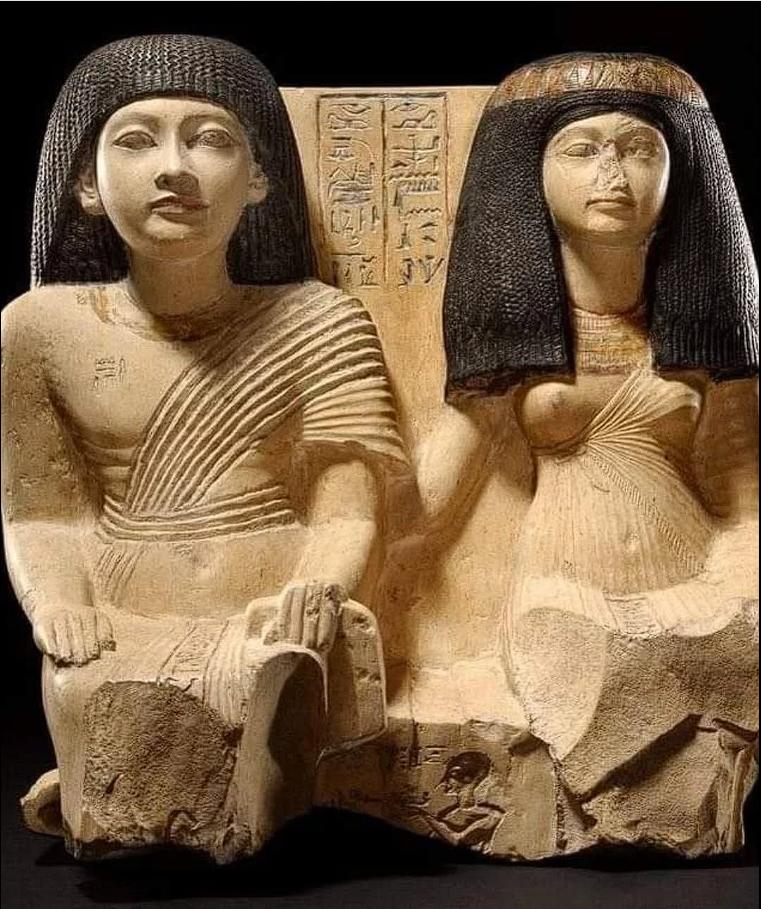Carved from the enduring greywacke stone and intentionally left unfinished, this nearly life-size statue offers a captivating glimpse into a moment frozen in the annals of ancient Egyptian history—Pharaoh Menkaure (also known as Mycerinus) standing in majestic proximity to a queen, widely believed to be Khamerernebty II, his principal consort. Their pose exudes an aura of eternal poise and unwavering power, transcending the limitations of time and the incompleteness of the artwork.
An Unfinished Masterpiece from the Giza Valley Temple
Dating back to the illustrious 4th Dynasty of Egypt (circa 2490–2472 BCE), a period renowned for its monumental architectural achievements and sophisticated artistic expressions, this remarkable statue was unearthed within the valley temple complex of Menkaure at Giza. Its discovery near the base of the smallest, yet equally significant, pyramid on the iconic Giza plateau underscores its direct association with the pharaoh’s funerary cult and royal identity. Despite its unfinished state, the inherent beauty and meticulous precision of the carving remain strikingly undiminished, offering a testament to the unparalleled skill of the ancient Egyptian artisans.
The King’s Vital Stride: A Symbol of Eternal Rule
The depiction of King Menkaure striding forward with his left leg advanced is a deliberate and classic symbol within Egyptian royal sculpture, signifying vitality, dynamism, and the pharaoh’s eternal ability to lead and govern. This conventional pose reinforces the image of a powerful and enduring ruler, forever present in the temporal and spiritual realms.
The Queen’s Supportive Embrace: Unity and Political Significance
Standing closely beside the pharaoh, the queen, likely Khamerernebty II, offers a gentle yet significant gesture of support and unity. Her hand rests delicately on Menkaure’s arm, a visual representation of their close bond, familial harmony, and potentially a powerful symbol of political alliance and shared authority within the royal court and the kingdom.
Serene and Timeless Expressions: Divine Representation
The expressions etched onto the faces of both Menkaure and Khamerernebty II are remarkably serene, timeless, and idealized. These were not intended as mere portraits capturing individual likeness but rather as divine representations, embodying the idealized characteristics of Egyptian royalty and their semi-divine status as intermediaries between the mortal and spiritual worlds.
Adherence to Royal Conventions: A Masterclass in Egyptian Sculpture
Egyptian royal sculpture adhered to a strict set of artistic conventions, designed to convey specific messages about the pharaoh’s power, divinity, and eternal nature. This unfinished statue of Menkaure and Khamerernebty II serves as a masterclass in these enduring traditions, showcasing the hallmarks of Egyptian royal artistic expression: symmetry, frontality, and the portrayal of eternal youth.
Symmetry and Balance: Reflecting Cosmic Order
The principle of symmetry is meticulously observed in the composition of the statue, reflecting the ancient Egyptian belief in cosmic order and balance (Ma’at). The equal distribution of weight and the mirrored forms of the figures contribute to a sense of stability and eternal harmony, aligning the earthly rule of the pharaoh with the divine order of the universe.
Frontality: Engaging the Viewer with Royal Authority
The principle of frontality, where the figures are primarily intended to be viewed from the front, is another key convention of Egyptian royal sculpture. This direct gaze and frontal orientation were designed to engage the viewer directly with the royal authority and divine presence of the pharaoh and his consort, emphasizing their power and demanding respect.
Eternal Youth and Idealization: Transcending Mortality
Both Menkaure and Khamerernebty II are depicted with idealized features, embodying the concept of eternal youth and beauty. This artistic convention aimed to transcend the limitations of mortality, presenting the royal figures as eternally youthful and powerful, ensuring their enduring presence in the afterlife and their continued symbolic rule.
Bound by Power and Immortality: The Ideals of Egyptian Rulership
Together, the figures of Menkaure and Khamerernebty II in this unfinished yet powerful statue embody the core ideals of Egyptian rulership and divine authority. They represent not only a pharaoh and his consort, united by blood and earthly power, but also a symbolic representation of their divine connection and the promise of eternal life and enduring legacy within the ancient Egyptian belief system. This greywacke masterpiece, though incomplete, stands as a timeless testament to the enduring power and artistic sophistication of the 4th Dynasty.

CÁC TIN KHÁC
Mary Walton: The Forgotten Inventor Who Helped Clean Up America’s Cities
Tomb of Queen Nefertari in the Valley of the Queens, Egypt
Discover the Hypostyle Hall of the Temple of Hathor at Dendera
Venus de Losange: Unveiling the Mystery of a 20,000-Year-Old Paleolithic Icon